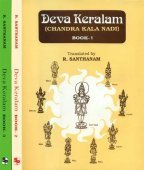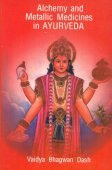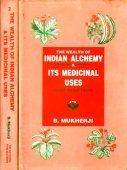Das, Ḍas, Dash, Dāś, Dās: 13 definitions
Introduction:
Das means something in Hinduism, Sanskrit, Hindi, biology. If you want to know the exact meaning, history, etymology or English translation of this term then check out the descriptions on this page. Add your comment or reference to a book if you want to contribute to this summary article.
The Sanskrit term Dāś can be transliterated into English as Das or Dash, using the IAST transliteration scheme (?).
In Hinduism
Vyakarana (Sanskrit grammar)
Source: Wikisource: A dictionary of Sanskrit grammarḌas (डस्).—Affix अस् (as) applied to the word श्वेतवाह (śvetavāha) and others at the end of a pada i.e when the word श्वेतवाह (śvetavāha) has got the पदसंज्ञा (padasaṃjñā). e.g. श्वेतवाः इन्द्रः । श्वेतवोभ्याम् (śvetavāḥ indraḥ | śvetavobhyām) cf.P.III.2.71 Vārt,1 and 2.

Vyakarana (व्याकरण, vyākaraṇa) refers to Sanskrit grammar and represents one of the six additional sciences (vedanga) to be studied along with the Vedas. Vyakarana concerns itself with the rules of Sanskrit grammar and linguistic analysis in order to establish the correct context of words and sentences.
Biology (plants and animals)
Source: Google Books: CRC World Dictionary (Regional names)Dash in Niger is the name of a plant defined with Commiphora africana in various botanical sources. This page contains potential references in Ayurveda, modern medicine, and other folk traditions or local practices It has the synonym Balsamea pilosa Engl. (among others).
Example references for further research on medicinal uses or toxicity (see latin names for full list):
· Fitoterapia (2008)
· Florae Senegambiae Tentamen (1831)
· Monographiae Phanerogamarum (1883)
· Journal of Ethnopharmacology (2005)
· Journal of Ethnopharmacology (2006)
· Journal of Ethnopharmacology (2004)
If you are looking for specific details regarding Dash, for example diet and recipes, extract dosage, health benefits, side effects, pregnancy safety, chemical composition, have a look at these references.

This sections includes definitions from the five kingdoms of living things: Animals, Plants, Fungi, Protists and Monera. It will include both the official binomial nomenclature (scientific names usually in Latin) as well as regional spellings and variants.
Languages of India and abroad
Sanskrit dictionary
Source: DDSA: The practical Sanskrit-English dictionaryDas (दस्).—I. 4 P. (dasyati)
1) To throw up, toss.
2) To decay, waste away, perish. -II. 1 P., 1 U. (daṃsati, daṃsayati-te)
1) To bite, destory, overpower.
2) To see.
3) To shine. -Caus. To exhaust, weary; आविवासन्तो दसयन्त भूम (āvivāsanto dasayanta bhūma) Ṛgveda 5.45.3.
--- OR ---
Dāś (दाश्).—I. 1, 1 U. (dāśati-te, dāśayati-te)
1) To give, grant; अग्नीषोमा य आहुतिं यो वां दाशाद्धविष्कृतिम् (agnīṣomā ya āhutiṃ yo vāṃ dāśāddhaviṣkṛtim) Ṛgveda 1.93.3.
2) To offer an oblation; यो वा घृतेन दाशति (yo vā ghṛtena dāśati) Ṛgveda 1.93.1. -II. 5 P. (dāśnoti) To hurt, kill; दाश्नोति नमउक्तिभिः (dāśnoti namauktibhiḥ) Ṛgveda 8.4.6.
--- OR ---
Dās (दास्).—1 U., 5 P. = दाश् (dāś) q. v.
Source: Cologne Digital Sanskrit Dictionaries: Edgerton Buddhist Hybrid Sanskrit DictionaryDaś (दश्) or Daśay.—(daś-, daśay-) , m.c. for Sanskrit darś(ay)- (MIndic dass-, daṃs-), show; see § 2.87.
Source: Cologne Digital Sanskrit Dictionaries: Shabda-Sagara Sanskrit-English DictionaryDaś (दश्).—[(i) daśi] r. 1st and 10th cls. (daśati daṃśayati-te) 1. To bite or sting. 2. To arm, to put on armour. 3. To see. r. 10th cl. (daṃśayate) To shine. With upa, to be in trouble, to be reduced in circumstances. With sam, to pinch, to nip, to bite. dīptau cu0 ubha0 aka0 seṭ idit . daṃśanārthe cu0 ātma0 and bhvā0 pa0 .
--- OR ---
Das (दस्).—[(ir, u) iradasu] r. 4th cl. (dasyati) 1. To lose. 2. To throw or direct, to throw up or toss. r. 10th cl. (dasayate) To see. (i) dasi r. 1st and 10 cls. (daṃsati, daṃsayati) 1. To bite or string. 2. To see. 3. To shine. divā0 utkṣepe, upakṣaye apakṣaye ca aka0 pa0 saka0 seṭ . darśane daṃśane ca cu0 ā0 saka0 seṭ idit . pakṣe bhvā0 pa0 .
--- OR ---
Dāś (दाश्).—[(ṛ) dāśṛ] r. 1st cl. (dāśati-te) 10th cl. (dāśayati-te) To give 5th cl. (dāśnoti) To hurt, to injure or kill: see dāsa . bhvā0 ubha0 saka0 seṭ . curā0 ubha0 . svādi0 pa0 .
--- OR ---
Dās (दास्).—[(ṛ) dāsṛ] r. 1st cl. (dāsati-te) To give; also dāśa r. 5th cl. (dāsnoti) To hurt, to injure, to wound or kill: this and dāśa, in the last sense, are restricted by some authorities to the Vedas. bhvā0 ubha0 saka0 seṭ . svā0 para0 .
--- OR ---
Daṣ (दष्).—[(ira, au) iradaṣau] r. 4th cl. (duṣyati) 1. To do or act wrong or improperly. 2. To be impure. With pra and āṅa prefixed, To become manifest or apparent. divā0 para0 aka0 aniṭ .
Source: Cologne Digital Sanskrit Dictionaries: Benfey Sanskrit-English DictionaryDas (दस्).—i. 4, [Parasmaipada.] To become exhausted (ved.).
--- OR ---
Dāś (दाश्).—i. 1, [Parasmaipada.] 1. To worship,
Das (दस्).—dasyati [participle] dasta suffer want, languish. [Causative] dasayate exhaust, consume. apa, upa, pra & vi be exhausted, be wanting, fail.
--- OR ---
Dāś (दाश्).—1. dāśati dāṣṭi & dāśnoti make offering, sacrifice, grant, bestow, dedicate, serve a god ([dative]) with ([instrumental]), be pious or religious. [Causative] dāśayati offer. — Cf. dāśvas.
--- OR ---
Dāś (दाश्).—2. [feminine] worship, [masculine] ([nominative] dās) worshipper.
--- OR ---
Dās (दास्).—dāsati [with] abhi bear ill-will towards, try to harm, persecute.
Source: Cologne Digital Sanskrit Dictionaries: Monier-Williams Sanskrit-English Dictionary1) Das (दस्):—[class] 1. 4. (p. dasamāna; [imperfect tense] [plural] adasyan)
—to suffer want, become exhausted, [Ṛg-veda iv, 134, 5] ([Nirukta, by Yāska i. 9]), [Taittirīya-saṃhitā i, 6, 11, 3];—= upa- √kṣip, [Dhātupāṭha] :—[Causal] [Ātmanepada] (1. sg. saye; [subjunctive] [plural] sayanta)
—to exhaust, [iv, 2, 5, 4; Ṛg-veda v. 45, 3]; cf. apa-, upa-, anūpa-, pra-, vi-;—saṃ-dadasvas, draviṇo-das;—δεῖ
2) Dāś (दाश्):—1. dāś (the finite forms only in [Ṛg-veda] and once in [Śatapatha-brāhmaṇa] See below) [class] 1. [Parasmaipada] dāśati, [i, 93, 10; 151, 7 etc.] [Ātmanepada] te, [Dhātupāṭha xxi, 18] (rarely [class] 2. [Parasmaipada] 5. dāṣṭi, [i, 127, 4]; dāśnoti, [viii, 4, 6][the latter also = √dās]; [perfect tense] dadāsa, [i, 36, 4 etc.]; [subjunctive] dadāśati, śas, śat, [i, 156, 2; 94, 15; 91, 20 etc.]; p. dadāśvas [dative case] śuṣe, [i, 112, 20 etc.], dāśivas [only [Sāma-veda i, 2, 5, 1, 1]] and dāśvas [see below]), to serve or honour a god ([dative case] or [accusative]) with ([instrumental case]), [i, 68, 6; vii, 14, 3 etc.; v, 41, 16; viii, 19, 4];
2) — offer or present ([accusative]) to ([dative case]), grant, give, bestow, [i, 93, 3; ii, 19, 4 etc.] :—[Causal] [Parasmaipada] dāśayati, offer, present, [Śatapatha-brāhmaṇa i, 6, 2, 5.]cf. daśasya, and [Greek] δωκ in ἔ-δωκ-α -a, δέ-δωκ-α -a.
3) 2. dāś f. worship, veneration, [Ṛg-veda i, 127, 7]
4) m. worshipper, [vi, 16, 26] (cf. dūand puro-).
5) Dās (दास्):—1. dās [class] 1. [Ātmanepada] [Parasmaipada] dāsati, te, to give ([Dhātupāṭha xxi, 28]) [class] 5. [Parasmaipada] dāsnoti ([varia lectio] for dāś, [Vopadeva; ib. xxvii, 32]), to hurt, injure. (There occurs only dāsati with abhi; See sub voce)
6) 2. dās = 2. dāś, see su-dās, p. 1224.
Source: Cologne Digital Sanskrit Dictionaries: Yates Sanskrit-English Dictionary1) Daś (दश्):—(i) daśati daṃśayati 1. 10. a. To bite or sting; to put on armour; to see. daṃśayate 10. d. to shine. With upa to be in trouble; with saṃ to pinch, to nip, to bite.
2) Das (दस्):—(ya, u, ira) dasyati 4. a. To lose; to throw. (ka, ṅa) dasayate 10. d. To see (ki, i) daṃsati daṃsayati 1. 10. a. To bite; to see; to shine.
3) Dāś (दाश्):—(ña, ṛ) dāśati, te 1. c. To give. (ka, ṅa) dāśayate 10. d. Idem. (na) dāśnoti 5. a. To hurt.
4) Dās (दास्):—(ña, ṛ) dāsati, te 1. c. To give. (na) dāsnoti 5. a. To hurt.
[Sanskrit to German]
Sanskrit, also spelled संस्कृतम् (saṃskṛtam), is an ancient language of India commonly seen as the grandmother of the Indo-European language family (even English!). Closely allied with Prakrit and Pali, Sanskrit is more exhaustive in both grammar and terms and has the most extensive collection of literature in the world, greatly surpassing its sister-languages Greek and Latin.
Hindi dictionary
Source: DDSA: A practical Hindi-English dictionary1) Dash in Hindi refers in English to:—(nm) a dash..—dash (डैश) is alternatively transliterated as Ḍaiśa.
2) Das in Hindi refers in English to:—(a) ten; (nm) the number ten; —[lakha] a million; —[nambari] a notorious criminal; [dasom dishaom mem] all round, all over, everywhere..—das (दस) is alternatively transliterated as Dasa.
...
Nepali dictionary
Source: unoes: Nepali-English DictionaryDash is another spelling for दश [daśa].—n./adj. num. ten; 10;
Nepali is the primary language of the Nepalese people counting almost 20 million native speakers. The country of Nepal is situated in the Himalaya mountain range to the north of India.
See also (Relevant definitions)
Starts with (+1036): Daasatv, Das padas, Das plasare, Dasa, Dasa Tathagata Bala, Dasa gosvamin, Dasa Parami, Dasa sharman, Dasa-bhritaka, Dasabala, Dasabala Kassapa, Dasabala Sutta, Dasabala Vagga, Dasabanajiga, Dasabharya, Dasabhava, Dasabhavashtaka, Dasabrahmana Jataka, Dasabusane, Dasabyata.
Ends with (+167): Abhaktacchandas, Abhivyudas, Acaramaryadas, Acchandas, Acharamaryadas, Achchhandas, Achodas, Acodas, Adas, Adas pedas, Aksharacchandas, Aksharachandas, Aksharachhandas, Amarasadas, Anadas, Anashtavedas, Antahsadas, Antahsthacchandas, Antahsthachandas, Antasthachandas.
Full-text (+11829): Dravinodas, Dashu, Sudas, Phadasampadani, Dasera, Dashashvamedha, Dasa, Dhodho, Dasheraka, Abaka, Nashta, Kosalanem, Dashanandini, Dashapati, Dashataya, Dasatva, Dashvams, Dasaka, Dashvat, Dashay.
Relevant text
Search found 154 books and stories containing Das, Ḍas, Dash, Dāś, Dās, Daś, Daṣ; (plurals include: Dases, Ḍases, Dashes, Dāśs, Dāses, Daśs, Daṣs). You can also click to the full overview containing English textual excerpts. Below are direct links for the most relevant articles:
The Religion and Philosophy of Tevaram (Thevaram) (by M. A. Dorai Rangaswamy)
Chapter 96 - Thiruvanchikulam or Tiruvancaikkalam (Hymn 4) < [Volume 3.7 - Unto the last]
Chapter 28 - Thiru-Venjamakoodal or Tiru-Vencamakkutal (Hymn 42) < [Volume 3.3 - Pilgrim’s progress: to Chola (later?)]
Chapter 2 - Thiruthuraiyur or Tirutturaiyur (Hymn 13) < [Volume 3.1 - Pilgrim’s progress: to Arur]
My Life is Your Eternal Game < [April – June, 1997]
The Still Sad Story of Humanity < [October – December, 1982]
The Stranger in The Tent < [January – March, 1981]
Jain Remains of Ancient Bengal (by Shubha Majumder)
Regional Study of Jainism < [Chapter 1 - Introduction and Scope of the Present Study]
Abandoned Temples/Structural Ruins Containing Sculptural Specimens < [Chapter 5 - Jaina Architectural and Sculptural Remains]
Jainism in ancient Bengal during the early medieval period < [Chapter 3 - Historical Background of Jainism in Ancient Bengal]
Rig Veda (translation and commentary) (by H. H. Wilson)
Sahitya-kaumudi by Baladeva Vidyabhushana (by Gaurapada Dāsa)
Tiruvaymoli (Thiruvaimozhi): English translation (by S. Satyamurthi Ayyangar)
Pasuram 2.1.4 < [Section 1 - First Tiruvaymoli (Vayum tirai)]
Pasuram 9.10.1 < [Section 10 - Tenth Tiruvaymoli (Malai nanni)]
Related products




